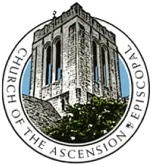From the Rector…
There is a lot of disparity between the northside and the southside neighborhood around the Ascension. Yesterday the staff took a walk through the streets surrounding CoA. The boys went south. The girls went north. When we met back up after our walk, we shared our observations—what we saw, smelled, and heard.
For the most part our observations lined up with our general views of the area but there were a few surprises. For instance, there were no businesses mixed into the houses (save one entertainment venue) on the southside of the church. To the north, we saw several businesses. There were no empty lots to the south and several to the north. The south had mostly single-family homes whereas the north had a significant number of multi-family dwellings. The houses from Perry to Hull were in fairly good condition. But the houses from Hull to Norman Bridge Rd were in less favorable condition. We didn’t see a lot of litter except in the woods that border our property—and that piece of property was in the worst condition of all the empty lots we saw.
Those observations caused us to draw a few conclusions. There are two distinct neighborhoods on either side of the church—the southern side appears to be more affluent than the northern side. Our front doors—to the church and the offices—faces the more affluent parts of our neighborhood to the south and west. A wall faces the more socio-economically depressed side of our neighborhood to the north and east. This prompted one of our staff members to suggest that though we might come through our front doors for ministry, we can exit out our backdoor for mission. Maybe another way to think about that is that we have ministry opportunities out our front door and mission opportunities out the back door.
That comment seemed telling as we considered that our feeding programs happen in the back of our church. The entrance to ADS—a significant part of our mission to the world—is located on the northern side of our campus. Joshua House—which has demonstrated strong organic growth in mission focus—is on the north side of our campus. The mission field is ripe, and it is right outside our own backdoor!
Another observation we made was our lack of fences. For many of the staff that felt like an opportunity for engagement. Fences often signify the desire to either keep something in or something out (or maybe both). It was telling to us that we often see people sitting in the Transfiguration Garden or on our front lawn, but rarely do we see people in the Waldo Garden or the Sundial Garden—both if which have walls that serve as boundaries like a fence. We felt that our lack of a fence for the majority of our property was a powerful symbol that we had not shut ourselves off from our neighboring community; that the building and nurturing of relationships was more than possible; and that our willingness to stay available to our community was an asset in that relationship building.
We aren’t completely sure what we are going to do with the information we are beginning to collect about our neighborhood. But we think it is important that we begin to understand who our neighbors are as we stand as a witness to them in this place. For now, we will continue to greet and meet them and try to establish and nurture some relationships. We hope to connect with our neighbors and hear their needs—not necessarily to do for them, but to be with them and walk this path together. In that way, our neighbors—whether front door or back door people—might grow in fellowship and spirit with us.
The church carries on the mission of bearing the Good News of Jesus Christ. When a lawyer asks Jesus who his neighbor is, Jesus replies by telling a parable about a Samaritan who tended to an injured and broken man on the side of the road. As a church, as bearers of the Gospel, we are called to pay attention to those who are broken in spirit and not ignore them. We are called to be a good neighbor.
Light and Life,
Candice+
